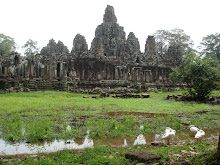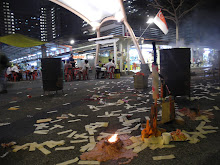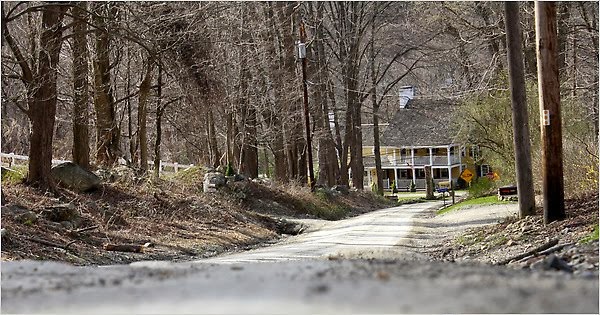
Gong Xi Fa Cai! Happy New Year! 2009 (or 4707 on the Chinese calendar) is the Year of the Ox. One characterization describes Ox as patient people who speak little and inspire confidence in others. However, an Ox can be bigoted, eccentric and anger easily. Ox people are mentally and physically alert. They are easy-going, yet remarkably stubborn. In essence, Ox people just want to spend the day in a sunny meadow minding their own business and if someone or something interrupts, then they’ll get the horns. I read somewhere that President Obama is an Ox. James is a rabbit. I am a horse.
The Chinese Lunar New Year began on Monday, 26 January. I spent the week leading up to the big night researching and preparing. It was my first and I wanted to celebrate, as was the norm. I researched traditions, symbols, and customs that stretched back for centuries. One week wasn’t enough time to learn the details let alone prepare for the Reunion Feast on the 25th. That is the big night when families celebrate togetherness by eating a big dinner and exchanging Hung-Bao or red packets. I decided to stick with the basic decorations and food stuffs.
The Chinese Lunar New Year began on Monday, 26 January. I spent the week leading up to the big night researching and preparing. It was my first and I wanted to celebrate, as was the norm. I researched traditions, symbols, and customs that stretched back for centuries. One week wasn’t enough time to learn the details let alone prepare for the Reunion Feast on the 25th. That is the big night when families celebrate togetherness by eating a big dinner and exchanging Hung-Bao or red packets. I decided to stick with the basic decorations and food stuffs.
To guarantee a good year, according to tradition, I had to clean house, get a haircut, buy new clothes, and payback any money owed. I also had to buy decorations and food. James’ co-workers warned me that the city shuts down for days after the 25th, so food we was on the top of my list. It took a full day to scrub, sweep, and clean the apartment and patio. The haircut would have to wait until I found a salon or stylist specializing in westerner’s hair, but I planned to do it up for the Reunion Feast. I bought a new top. The only money I "owed" was a Verizon bill in dispute, but it had to wait until after the Lunar New Year. I finished the week by focusing on decking my halls with fu.

With checklist in hand, I set out to buy decorations and fruits. All around the city, I noticed business centers, hotel lobbies, and public spaces decorated in observance. The city was colorful and bright. When I entered Chinatown, I was completely blown away! Every square inch of every block in the district was festooned with banners, baubles, blinking lights and, of course, ornamental oxen. The streets were closed to vehicle traffic, but open for business. Red-tented stalls lined the sidewalks and people were busy moving from one booth to another gathering the necessary things to ensure wealth, abundance, and prosperity in the New Year.
Pagoda Street was a sea of red and gold, with a sprinkling of other colors. It was a dizzying display of candies, fruits, tschokies, souvenirs, costumes, and fireworks. The works! Music plinked over speakers tied to light posts and, just like the Ohio State Fair’s Lausche Building, there were booths featuring wonder products being sold by salesmen speaking into microphone headsets while giving live demonstrations. The more I walked the more I heard other hawkers selling their goods while talking into microphones - talking above the people in the streets and the music in the air. It all sounded like Dr. Seuss language: yekko, nizzards, sneedle for sale.

Chinatown was Tschoka Nirvana. However, it didn’t feel like heaven with the heat, humidity and hustle. Trying to fulfill the list would have been easy with all the choices, but I was too stunned by the action to hunt and peck for my New Year decorations and treats. I was pushed, elbowed, and even screamed at in one booth! I managed to purchase a fu and a paper pineapple, as well as a gold ox ornament with red tassel and a small rubber Mickey Mouse ornament with red tassel. The vendor chuckled when I asked him the symbolism of Mickey Mouse in the ancient Chinese New Year tradition. Feeling completely overwhelmed, I went home before I completed the list.

With checklist in hand, I set out to buy decorations and fruits. All around the city, I noticed business centers, hotel lobbies, and public spaces decorated in observance. The city was colorful and bright. When I entered Chinatown, I was completely blown away! Every square inch of every block in the district was festooned with banners, baubles, blinking lights and, of course, ornamental oxen. The streets were closed to vehicle traffic, but open for business. Red-tented stalls lined the sidewalks and people were busy moving from one booth to another gathering the necessary things to ensure wealth, abundance, and prosperity in the New Year.
Pagoda Street was a sea of red and gold, with a sprinkling of other colors. It was a dizzying display of candies, fruits, tschokies, souvenirs, costumes, and fireworks. The works! Music plinked over speakers tied to light posts and, just like the Ohio State Fair’s Lausche Building, there were booths featuring wonder products being sold by salesmen speaking into microphone headsets while giving live demonstrations. The more I walked the more I heard other hawkers selling their goods while talking into microphones - talking above the people in the streets and the music in the air. It all sounded like Dr. Seuss language: yekko, nizzards, sneedle for sale.

Chinatown was Tschoka Nirvana. However, it didn’t feel like heaven with the heat, humidity and hustle. Trying to fulfill the list would have been easy with all the choices, but I was too stunned by the action to hunt and peck for my New Year decorations and treats. I was pushed, elbowed, and even screamed at in one booth! I managed to purchase a fu and a paper pineapple, as well as a gold ox ornament with red tassel and a small rubber Mickey Mouse ornament with red tassel. The vendor chuckled when I asked him the symbolism of Mickey Mouse in the ancient Chinese New Year tradition. Feeling completely overwhelmed, I went home before I completed the list.
Sunday, 25 January, was the night of the Reunion Feast. We’d been looking forward to this night all week. James made reservation at our favorite restaurant, Scarlett, where the rooftop dining room overlooks Chinatown. It was the ideal place to ring in our first Lunar New Year and to celebrate James’ two-day break. We should have known something was wrong when the wait for the taxi after texting took nearly 20 minutes (it usually takes 3), but we just guessed that the city must be busy, like NYC on 31 January. We were wrong! The taxi driver laughed at us when we told him our destination. The town was dark and empty, like downtown Columbus on any given night. When we reached the restaurant it was closed – Chinatown and the surrounding area was closed. Ooops! James checked his Blackberry and remembered that the hostess said they were closed on Sunday. He made reservations for Monday instead. We shared a laugh with our driver and toured the city looking for an open restaurant. The driver made clear that the Reunion Fest is a night to be with family. That explained why all businesses, buildings, and bars were closed. He suggested we return to Chinatown around midnight when people enter the streets cheering and lighting firecrackers.
After about 15 minutes, we found a neon shamrock burning bright at the Dubliner pub. An Irish pub doesn’t look anything like a Chinese restaurant. Fish-and-chips don’t taste like dumplings and a pint beer doesn’t sip like a glass of champagne. Yet, that didn’t stop us from celebrating with Chinese spirit. We toasted our good fortune of finding an open restaurant, the wealth of laughter, and our blossoming life in Singapore.

























